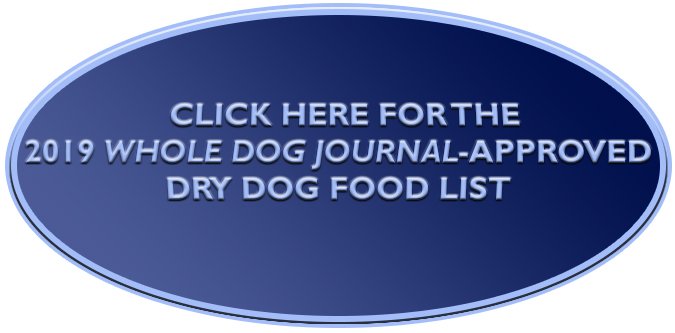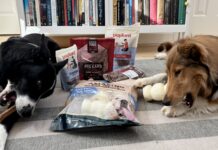The Dog Food Label Information That Matters Most
1. Ingredients
In our opinion, the ingredients list tells you more about the product’s quality than anything else. It’s a highly regulated section of the label; the ingredients must be listed in descending order of their inclusion in the food by weight.

In order to appear on our approved dry dog foods list, a dry dog food must have the following:
Hallmarks of Quality Dry Dog Food
Lots of animal protein at the top of the ingredients list. Ingredients in pet food are listed in order of the weight of that ingredient in the formula, so you want to see a named animal protein or named animal protein meal first on the ingredients list. (“Named” means the species is identified: chicken, beef, lamb, etc. “Meal” means a dry, rendered product made from an identified species.)
When a fresh meat is first on the ingredient list, there should be a named animal-protein meal immediately or closely following the meat. Fresh meat contains a lot of moisture (which is heavy), so if meat is first on the list, it acts like a diluted protein source; while it adds an appealing flavor and aroma to the food, it doesn’t actually contribute that much protein. That’s why another named source of animal protein should appear in the top two or three ingredients.
When vegetables, fruits, grains, and/or carbohydrate sources such as potatoes, chickpeas, or sweet potatoes are used, they should be whole. Fresh, unprocessed food ingredients contain nutrients in all their complex glory, with their vitamins, enzymes, and antioxidants intact.
Bonus points for products that are made with ingredients that are certified as organic, humanely raised, or sustainably farmed. We understand that it’s good marketing, but we also like to buy from companies who support shelters or rescue, manufacture in “green” plants, and participate in recycling and waste reduction programs.
Dog Food Label Disqualifiers
Here are some things to look out for – undesirable attributes that indicate a lower-quality food:

Meat byproducts, poultry byproducts, meat byproduct meal, and poultry byproduct meal. Many of these animal protein sources are nutritious, but are often handled with far less care than more expensive animal protein sources (i.e., without refrigeration and with less sanitation).
“Generic” fat sources. “Animal fat” can literally be any mixed fat of animal origin. “Poultry” fat is not quite as suspect as “animal fat,” but “chicken fat” or “duck fat” is better (and traceable).
Watch out for a practice commonly called “ingredient splitting,” whereby two or more very similar food “fractions” appear on the ingredients list. Because the ingredients are listed in descending order of their weight, a manufacturer can make it appear that a high-quality ingredient is represented in the food in a greater amount than it really is. This is accomplished by using several fractions or versions of an ingredient as separate ingredients (i.e., rice, brewer’s rice, rice bran, rice protein meal). If all the iterations of that ingredient were combined or reconstituted, they would outweigh the higher-quality ingredient, pushing it down on the ingredients list.
We don’t recommend foods that use animal plasma or blood meal as a protein source.
Added sweeteners. Sweeteners are used to increase the palatability of foods comprised mainly of carbohydrate sources (and containing less animal protein).
Artificial colors, flavors, or preservatives (such as BHA, BHT, ethoxyquin). The color of the food doesn’t matter to your dog. And it should be flavored well enough with healthy meats and fats to be enticing. Natural preservatives, such as mixed tocopherols, can be used instead.

Getty Images Plus | andresr
2. Guaranteed Analysis (GA)
Listed in this section of the label are the minimum amounts of protein and fat that are present in the food (the amounts may actually be higher than those listed), and the maximum amounts of moisture (water) and fiber that are present in the food. This is the guaranteed analysis.
Minimum levels are used for protein and fat because those are the most important values in a dog’s food; it’s what you are paying for. Maximums are used for moisture and fiber because this is not what you want to pay for!
Manufacturers may (but are not required to) include other nutrient values in the GA. By doing so, they are legally guaranteeing those amounts in the food, and this is subject to testing and enforcement by state feed control officials. It’s a good way for a pet food maker to put their money where their mouths are concerning claims of special benefit from the inclusion of certain nutrients, such as DHA or glycosaminoglycans (e.g., chondroitin).
When you switch or rotate foods, you need to pay particular attention to the amount of protein and fat in the products; try to find products with protein and fat levels that suit your dog. If his weight and condition are perfect, find other products with macronutrient levels in the same range. As just one example, switching your older, slightly overweight dog to a food that contains twice the protein and fat that she’s been accustomed to could invite disaster in the form of crippling weight gain or even pancreatitis.

3. Nutritional Adequacy Statement
It’s crazy that this critical bit of information is difficult to find on most dog-food labels. The statement is usually in tiny print, but can be identified by the phrases “complete and balanced” and “the Association of American Feed Control Officials” (AAFCO, whose nutritional guidelines legally define “complete and balanced”).
There are two AAFCO dog food nutrient profiles – tables that detail the minimum (and in some cases, maximum) levels of each nutrient required by dogs. One profile lists the nutrient requirement levels for “growth and reproduction” and the other profile lists those for “adult maintenance.” In general, the nutritional requirements for dogs engaged in the process of growth and reproduction are higher than those for adult dog maintenance.
Statements that claim that a product provides complete and balanced nutrition for “growth and reproduction,” “puppies,” or “dogs of all life stages” are equivalent; a product with any of those claims has met the “growth and reproduction” nutritional profile. But if the product is complete and balanced for “adult maintenance” only, it will be nutritionally inadequate for puppies.







Can you give advice and recommendations on puppy food?
I am a cockapoo breeder and for 14 years I weaned by puppies onto Dick Van Patten’s Original Ultra Premium Natural Balance small breed bites and never had a problem. Recently Natural Balance changed the formula to grain free. I do not plan to use any grain free food on my dogs or puppies due to the ongoing study being done by the FDA concerning grain free foods. I’ve considered Fromm’s Gold for Puppies but am at a loss after all these years. Can you help?
Any word on the Costco Kirkland brand kibble or canned? (salmon/sweet potato. chicken, turkey, and beef)
Thanks,
Glenn
I’m interested in this as well!
Hello
I see your approved list for dog food, is there a breakdown on the best foods for small breeds, senior dogs?
Do you have a list of the top 10 foods for a small breed dogs? Thank you Mark 602-421-7643
The Natures Variety “Be Natural” food is a small kibble that is perfect for small breeds…my Blue Boston Terrier-Cooper loves it. I have served the Instinct brand for years and am really glad for this new Be Natural option with brown rice and oatmeal.
It is listed as Instinct
Is there a way to check on why a certain food is not on the list? I’ve been feeding Ziwi Peak Venison to a dog with food allergies to more usual ingredients . It’s very expensive and I thought it was very good. But it’s not on the list. Is that because of the cost or the quality?
I’m curious as to why Nature’s Logic dog food doesn’t seem to ever appear on this list. Is it because they rely on their food ingredients for nutritional balance instead of adding synthetic vitamin/mineral additives?
I do not see Canine Caviar o the 2019 list. I have seen it on your previous lists. Can you give the reason why you have taken it off.
Are you going to update this list with information related to the DCM issues? Legumes don’t appear to be safe in large amounts.
Can you give recommendations for large breed puppy food?
I was using Purina Pro Plan Large Breed puppy because of the uncertainty of the grain free food containing potatoes and lentil published by the FDA. I am now feeding Victor Professional All Stages to my puppy as well as my two year old Golden Retriever. I see the list was published before all this came out. What are your thoughts on Victor Foods?
What foods on the list are AAFCO approved? Specifically looking for grain inclusive.
I have a 2 year old English Mastiff. Are your recommendations the same?
How about Royal Canin? I have a six month dachshund puppy, and have had him on the ROYAL CANIN PUPPY SMALL/PETIT, since bringing him home in May.
Please give your thoughts on this and say something about PUPPY FOODS.
Is anyone from Whole Dog Journal going to address these questions? Some go back 3 months.
2 questions.
1. Where can I find the list of the 16 brands of Dog food that I should stay away from , DCM?
2. I read the article that Nancy did in July regarding all of this. I am a bit confused, here is why. On your list of approved foods for 2019, Acana is on that list. I feed Acana. In the article where the inclusion of peas,lentils,chickpeas, is discussed. It states that , if these ingredients are in the top 5, for now you would look at feeding another food.
Thank you for help,
Leanne
I am clicking around looking for the 2019 list of approved wet food and not finding it. Does it even exist? Babbo
I never see answers to reader questions but I’ll ask why Nature’s Logic is not on the 2019 list.
I have an 8 year old female German Shorthaired Pointer with several allergies. We’ve had her tested twice over the years and she is allergic to much of the stuff in commercial dog food. We were feeding a raw diet for many years but that got to be too much so we recently put her on bagged food. The ONLY one she can eat is ACANA Pork and Squash. It seems like every other dog food out there uses Flaxseed or Rice and she’s allergic to those. She’s allergic to: Barley, Beef, Beet Pulp, Brewers Yeast, Duck, Fish Mix, Flaxseed, Kangaroo, Lamb, Liver, Milk, Pinto Beans, Rabbit, Rice, and Venison. Anyone know of a dog food that doesn’t contain these ingredients?
I am a new subscriber to Whole Dog Journal and was wondering if you guys are going to answer the above questions. I not why have a place for comments. Makes the Journal look bad, just my opinion..
Your list contradicts your most recent article on DCM. What gives?
So many questions… so few answers!